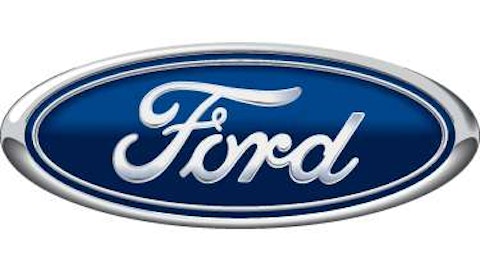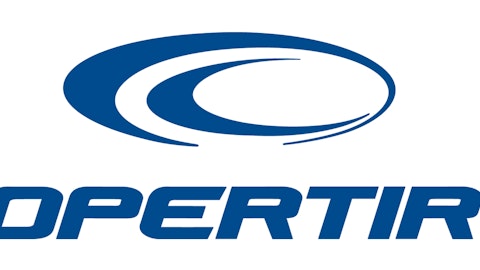The current market value of Tesla Motors Inc (NASDAQ:TSLA) is $15.56 billion. At this level, Tesla’s market cap is a little less than a quarter of Ford Motor Company (NYSE:F)’s market value or about a quarter of General Motors Company (NYSE:GM)’s market value. Even though last quarter was Tesla’s first profitable quarter (and even that came thanks to selling certain tax allowances), the company is already priced for perfection and beyond. How much would Tesla Motors Inc (NASDAQ:TSLA) have to grow in order to justify today’s share price? Let’s find out.

Revenue and income potential
This year, Tesla Motors Inc (NASDAQ:TSLA) is expected to sell 20,000 Model S cars, most of which will be the high-end models with large battery packages. If the average car price is $80,000, this gives us $1.6 billion in revenue. Given the company’s gross margin of 17% last quarter, this gives us a gross profit figure of $272 million. For most car companies, operating margins are roughly half of gross margins, which would give the company operating income of $136 million. With additional revenue such as tax allowance sales and part sales to companies like Toyota, the company could earn somewhere between $150 and $200 million with the sale of 20,000 cars this year.
How about later on in the future?
In the longer term future, Tesla Motors Inc (NASDAQ:TSLA) is expected to ramp up production, become more efficient at building cars, take better advantage of economies of scale and become more profitable. It is said that Tesla Motors Inc (NASDAQ:TSLA) will be able to double its production every year for the next 5-6 years. In the later years, cheaper cars will join the mix and margins will suffer a little bit, but the efficiency gains I mentioned above will offset some of that.
Let’s say Tesla was able to double its production every year between now and 2017. It would be building 20,000 cars in 2013, 40,000 cars in 2014, 80,000 cars in 2015, 160,000 cars in 2016 and 320,000 cars in 2017. This sounds like a stretch goal, right? Well Tesla Motors Inc (NASDAQ:TSLA) is already priced as if it accomplished all this, and more.
Let’s say that by 2017, Tesla is selling 320,000 cars per year. In order for the company to sell this many cars, it would have to move from being a niche-player to “mainstream.” The company would have to spend loads of money on marketing and building a network of dealerships just like every other car company does. This would definitely eat into Tesla’s profit margins. After all, selling 20,000 cars and selling 320,000 cars take different approaches. Besides, by the time Tesla reaches such a high capacity, its employees will start unionizing just like they did in every car company. Keep in mind that Tesla’s operations are located in California, a strongly pro-union state.
So, what would Tesla’s 320,000 cars look like? Let’s go by hypothetical figures. Tesla could probably sell about 20,000 of the high end cars that cost $80,000 each. Then it could sell about 30,000 cars that cost around $65,000 each. Next, we would be looking at about 50,000 cars at $50,000 price range. The rest of the cars sold (220,000) would be cheaper cars. Elon Musk said that they would start selling $40,000 cars by mid-decade, and if Tesla were to reach a volume as high as 320,000 cars per year, the great majority of the cars sold would be cheaper cars since most people in the world still aren’t rich enough to afford cars that cost nearly six figures.
In this hypothetical situation, Tesla’s total revenue would be $14.85 billion. Higher-end cars would have gross margins closer to 25% (as we see in the luxury segment) and the lower-end cars would have gross margins closer to 17-18%. If we assign 25% gross margin to $80,000 cars, 22% gross margin to $65,000 cars, 20% gross margin to $50,000 cars and 18% gross margin to $40,000 cars (these numbers are pretty comparable in the industry), the company’s total gross profit would be $2.83 billion.
Now, the company would have higher marketing costs (in order to sell such a high volume) and higher taxes compared to what it does now. Assigning the company a net profit margin of 15% would yield $1.70 billion in net earnings. Assigning Tesla a forward P/E ratio of 10 (for 2017) would justify the company’s current value of almost $16 billion.
Priced for perfection
This is great, but the problem is that all of that might not happen. The company has to do so much work before all I listed above is accomplished, and it might take up to 7-10 years to accomplish that. Even if everything works out as planned and perfection is achieved, many years of solid growth would barely justify the company’s current share price. Then what if something goes wrong? Besides, those who are buying the company at the current price today would have to hope much better results than what I listed above because they would rather get a return on their investment.
Given how volatile and risky Tesla’s stock is, the stock price would have to appreciate faster than the overall market does in order to justify its value. On the other hand, even if the company’s share price stays flat for 5-6 years while the company grows aggressively, it would barely be rightly-valued. In that case, those who get the company’s shares today wouldn’t see any return on their investment.
Discounted cash analysis
Let’s say that Tesla will earn $150 million this year and the company is expected to grow its earnings by an average rate of 60% every year until 2020. Also, let’s keep in mind that the stock market is expected to result in returns of 11% annually every year. Conducting a discounted cash flow analysis shows that even if the company accomplishes earning $150 million this year and is able to grow it by 60% every year between now and 2020, its fair price would still be $156, which is not much higher than today’s price. When investors put their money in highly volatile stocks, they deserve to expect stronger returns.
Alternatives?
Currently, a number of car companies are dirt cheap compared to Tesla. For example, Ford Motor Company (NYSE:F) trades for 4 times gross profits and 10 times earnings. Excluding the company’s net cash position of $10 billion, it is looking at a forward P/E of 7, which is very attractive. Moving forward, Ford Motor Company (NYSE:F) expects to be profitable in Europe by 2015, which will increase the company’s earnings by another $2-3 billion (considering how it reported a loss of $2 billion in Europe last year. The company is growing very rapidly in Asia and it is well positioned to take advantage of the economic growth in South America. Ford is also expected to fund its pension plans fully by the mid-decade, which will free up a lot of cash for dividends and stock buybacks.
General Motors Company (NYSE:GM) trades for 13 times past earnings and 11 times future earnings. Keep in mind that GM has $26 billion in cash and when we exclude this figure from our analysis, the company’s forward P/E falls well below 10. The company is working on diversifying its portfolio and making electric and hybrid cars more affordable for the General Motors Company (NYSE:GM) public. The company hopes to reach breakeven in Europe by mid-decade and it’s doing really well in China. Once the problems in Europe are solved, GM will have even stronger earnings, supporting a better price. The company might feel some pressure when the government sells its shares back, but in the long term, things should be fine for General Motors Company (NYSE:GM).
At a time when car companies are trading for such low valuations, Tesla seems expensive. I understand that its disruptive, highly innovative, super-cool and everything (and I hope from the bottom of my heart that it’s successful), but the company is already priced for perfection at the moment. Still, it might not hurt to allocate a small portion of your portfolio to this company if you are so passionate about what it stands for.
Jacob Steinberg owns shares of Ford. The Motley Fool recommends Ford, General Motors, and Tesla Motors (NASDAQ:TSLA) . The Motley Fool owns shares of Ford and Tesla Motors. Jacob is a member of The Motley Fool Blog Network — entries represent the personal opinion of the blogger and are not formally edited.
The article Tesla: Priced for Perfection originally appeared on Fool.com is written by Jacob Steinberg.
Copyright © 1995 – 2013 The Motley Fool, LLC. All rights reserved. The Motley Fool has a disclosure policy.



